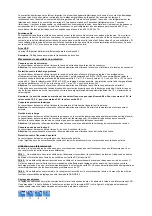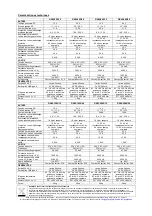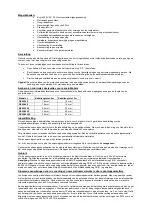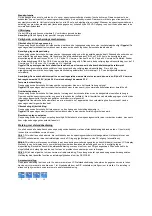
Features:
•
Real 230V AC 50Hz sinus output voltage
•
Galvanically
isolated
•
High
efficiency
•
Precise 50Hz frequency
•
Standby
function
•
Output- and temperature-controlled fan
•
Soft start function for consumers with high starting current
•
Various remote controls as accessories available
•
Overvoltage
shutdown
•
Adjustable, dynamic deep discharge protection
•
Overload
management
•
Short-circuit
shutdown
•
Reverse
polarity
protection
•
Temperature-activated protective circuit
Connection
For connecting the DC line, please use cable as short as possible with sufficient cross-section and ensure good contact, both to
the battery and to the voltage converter.
To thin or loose connectors may cause fire due to overheating!
•
Switch 8 on the front of the device must be set to “Off”.
•
A high-current fuse must be installed directly at the battery. If this fuse is missing, there is a risk of fire in case of
short-circuit of the two connection cables.
•
Now connect both connection cables to the battery (positive pole = red; negative pole = black.)
Attention!
The charge of the big capacitors may cause a spark inside the voltage converter when the fuse is connected. This is
perfectly harmless.
Recommended minimum cable cross-sections for connection cables
The recommended minimum cable cross-section for connection cables depends on the input voltage and the length of the used
cable.
Model No.
Cable length up to
2 m
Cable length up to
3 m
DSW-300
16 mm²
16 mm²
DSW-600
16 mm²
16 mm²
DSW-1200
25 mm²
35 mm²
DSW-2000
35 mm²
50 mm²
DSW-2000S
35 mm²
50 mm²
Ininitial operation
In order to guarantee appropriate initial operation, please read these operating instructions including safety
information completely and carefully before use.
Check the voltage converter before every start on possible damages. In case of damages, don’t start operation but contact an
authorized expert or our service.
Always ensure appropriate ventilation of your voltage converter. Never cover the ventilation slots of the voltage converter. Never
use the device in the vicinity of highly flammable materials.
Set up the voltage converter in such a way that it may not fall over or down.
During assembly ensure that the voltage converter is mounted in such a way that it is not accessible for children.
Danger of life!
Check the voltage requirements of the consumers to be connected. Connect only consumers whose voltage specifications and
output correspond with those of the voltage converter. Do not connect defect or damaged consumers.
Operation
To switch the voltage converter on and off activate the on/off switch 8. Now you may connect your 230V AC consumer. The
sequence of switching on/off and connecting the consumers is reversible.
Note:
When you switch off the voltage converter using on/off switch 8 or the remote control FB-01, no own power is required.
When you use the remote control FB-02 or FB-03 for this purpose, however, you only switch off the 230 V AC output with it, but
not the voltage converter. This is why it continues to require own power. To save energy, we recommend using switch 8 or the
remote control FB-01 only for switching off.
General notes on using AC consumers on voltage converters
In principle, all AC consumers may be operated on a sinus voltage converter. Observe, however, that for doing so you are
always restricted by the availability of the battery capacity and the output requirements of the individual AC consumers. For a
better assessment of the battery reserve, we recommend to familiarize yourself with some relevant characteristics of AC
consumers.
One important factor is the own power. Most consumers require a significantly higher starting current than indicated on the type
plate of the device. E.g. bulbs require starting current which is up to 8 times higher for approx. 1sec; refrigerators and TV
systems require starting current which is up to 10 times higher for 3 sec resp. approx. 1sec. This is why it is necessary when
choosing the voltage converter to ensure that corresponding output capacity is available. Therefore, a voltage converter must
provide a continuous output of 500 W (50 W x 10) to operate a small refrigerator with a continuous output of 50 W.




















